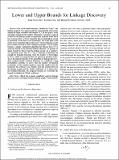Lower and upper bounds for linkage discovery
Author(s)
Choi, Sung-Soon; Jung, Kyomin; Moon, Byung-Ro
DownloadChoi-2009-Lower and Upper Boun.pdf (588.7Kb)
PUBLISHER_POLICY
Publisher Policy
Article is made available in accordance with the publisher's policy and may be subject to US copyright law. Please refer to the publisher's site for terms of use.
Terms of use
Metadata
Show full item recordAbstract
For a real-valued function f defined on {0,1}n , the linkage graph of f is a hypergraph that represents the interactions among the input variables with respect to f . In this paper, lower and upper bounds for the number of function evaluations required to discover the linkage graph are rigorously analyzed in the black box scenario. First, a lower bound for discovering linkage graph is presented. To the best of our knowledge, this is the first result on the lower bound for linkage discovery. The investigation on the lower bound is based on Yao's minimax principle. For the upper bounds, a simple randomized algorithm for linkage discovery is analyzed. Based on the Kruskal-Katona theorem, we present an upper bound for discovering the linkage graph. As a corollary, we rigorously prove that O(n [superscript 2]logn) function evaluations are enough for bounded functions when the number of hyperedges is O(n), which was suggested but not proven in previous works. To see the typical behavior of the algorithm for linkage discovery, three random models of fitness functions are considered. Using probabilistic methods, we prove that the number of function evaluations on the random models is generally smaller than the bound for the arbitrary case. Finally, from the relation between the linkage graph and the Walsh coefficients, it is shown that, for bounded functions, the proposed bounds are eventually the bounds for finding the Walsh coefficients.
Date issued
2009-02Department
Massachusetts Institute of Technology. Department of MathematicsJournal
IEEE Transactions on Evolutionary Computation,
Publisher
Institute of Electrical and Electronics Engineers
Citation
Sung-Soon Choi, Kyomin Jung, and Byung-Ro Moon. “Lower and Upper Bounds for Linkage Discovery.” Evolutionary Computation, IEEE Transactions on 13.2 (2009): 201-216. © 2009 Institute of Electrical and Electronics Engineers
Version: Final published version
ISSN
1089-778X
Keywords
lower and upper bounds, linkage graph, linkage discovery, complexity analysis, Walsh analysis, black box scenario